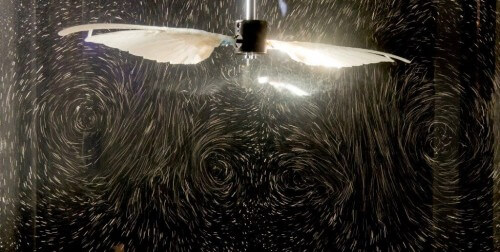This is what Professor Daniel Shiraz from the University of Colorado, Boulder, said at the 54th annual Israeli Conference on Aerospace Sciences at the Technion

"In view of past collisions between asteroids and the Earth, we are aware of the danger of such collisions and must prepare accordingly - so that we do not end up like the dinosaurs." So said Professor Daniel Scheeres from the University of Colorado, Boulder, after whom the asteroid 8887 Scheeres discovered in 1994 was named. He spoke at the Technion, at the 54th annual Israeli Conference on Aerospace Sciences.
"The asteroids are remnants from the formation of the solar system, so they teach us a lot about the beginning of the system's existence and its mechanics," he explained. Asteroids are relatively small bodies - their size ranges from the diameter of a grain of sand to 1,000 kilometers. These bodies are constantly changing under the influence of solar radiation and interactions with stars and other bodies. "NASA invests a lot in missions aimed at studying asteroids, and landing on an asteroid can serve as an excellent 'pilot' for a future landing on Mars," said Professor Shiraz. He talked about his involvement in OSIRIS-Rex - a mission in which a spacecraft will be launched in 2016 and return in 2023, and will bring to Earth extensive information about the asteroid Bennu and the mechanics of the formation of the solar system.
More on the subject on the science website
- In Russia, a meteorite weighing half a ton was removed from the impact event in Chelyabinsk in February 2013
- Watch the video: An asteroid passed close to Earth; NASA is increasing the search for asteroids that threaten humanity
- The source of the asteroid that wiped out the dinosaurs has been discovered
As part of the conference, a student project competition was held. Noam Naaman and Doreen Abseid, from the Faculty of Aeronautics and Space Engineering at the Technion, won first place in the "Research/Experimental Project" category for a unique study they conducted under the guidance of Dr. Yossi Elimelech. The two studied the effect of the shedding of the wings and their replacement on the flight capabilities of the hummingbird. This research has practical implications in the field of small aircraft. "It's a research project we did as part of the first degree," said Noam, who has been the Israeli champion in the 3,000m steeplechase for five consecutive years, "it required more hours from me than I spent on the rest of the degree."

Doreen, his partner in the winning project, said that "the research project was the most difficult task in the degree. During Hanukkah we sat for days and nights in the dark room, where we made the observation. It was a great effort, it was a great excitement to reach the competition and win first place."
Mrs. Armona Brendel, Technion graduate and chief system engineer at Elbit Systems, described the C-MUSIC (TM) PROGRAM project at the conference, within the framework of which Elbit develops systems to protect civilian aircraft against anti-aircraft missiles. The program was launched following the shooting at an Akiya plane, which took off from Mombasa Airport, Kenya, on November 28, 2002. The two shoulder-fired missiles fired at the plane missed it, but this event represented a significant turning point in the threat to civilian aircraft. "The program was launched in 2009. Our system, based on a laser, is designed to protect the plane during takeoff and landing. Military defense systems against anti-aircraft missiles already existed before, but the adaptation to the civilian market is very complicated due to various aspects such as budget, weight, safety and civil aviation regulations."
The innovative system of Elbit Systems is based on the detection of the missile and the launch of laser radiation that diverts it from its trajectory, and this within a few seconds. The first test flight, conducted in June 2013, was crowned a success.
"The Faculty of Aeronautics and Space Engineering was the first faculty to open its doors on the Technion's current campus," said Technion President Professor Peretz Lavi, who opened the second day of the conference. "The press ridiculed and asked: 'What will they fly over Carmel - kites?' Today there is no doubt that it was an excellent decision. From here came the people who established this field in Israel, and brought it to the level of a national league."
About five hundred engineers, scientists and experts in the fields of aeronautics and space in Israel and around the world participated in the annual Israeli conference for aviation and space sciences. The chairman of the articles committee, Professor Daniela Reva from the Faculty of Aeronautics and Space Engineering at the Technion, said that during the conference new research results were revealed and technological achievements and future developments were presented. The conference was organized by the Technion, Tel Aviv University, Ben-Gurion University, the Israel Aerospace Industries, Rafael, the Israel Military Industry, Elbit, the Israel Aerospace Sciences Association, and the Ministry of Defense.

5 תגובות
There is no need to stop the asteroid - it is enough to tilt its trajectory so that it does not hit the Earth.
It is also useful to prepare a number of manned shelters for backup, which can be a shelter for many years.
I don't think he can be stopped.
Joseph
I read that the explosion described in Armageddon would not have changed the collision course in any way.
Your numbers also seem strange to me: even GPS satellites move faster than 12000 km/h. Aren't your numbers very low?
There is a not bad and not so expensive proposal that NASA is running at one of the universities for an interceptor. Maybe write an article about it sometime.
One proposal talks about 2 missiles hitting the meteorite at the same time, the first opening a hatch and the second nuclear. Something similar to Armageddon.
A second proposal talks about an interceptor.
The main problem is that the meteorite's speed is about 30000 km/h and the speed of a conventional missile is about 12000 km/h. That's why several weeks' notice is required to calculate an exact route, and it's like waiting for the missile to hit a meteor at a certain point.
The problem is that the USA is in a recession and the world is slowing down, and NASA projects have stopped and are waiting for an economic tide, and are currently being conducted at the level of contingency plans.